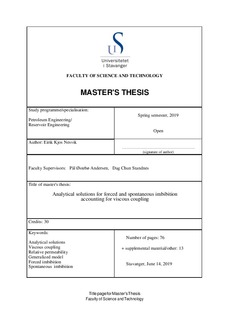| dc.description.abstract | Theoretical and experimental work has shown that fluid mobilities can depend on flow configuration, and are typically lower when fluids flow in opposite directions as compared to when they flow in the same direction. Such phenomena are referred to as fluid-fluid interactions or viscous coupling. Conventional modelling of two-phase flow, using simple, saturation dependent relative permeabilities is not able to account for variations in fluid mobilities with flow mode. As measurements are commonly taken during co-current flow, relative permeabilities have to be adjusted manually in order to correctly predict oil recovery in settings that are not purely co-current.
In this work we consider a generalized theory for multiphase flow in porous media based on mixture theory, where fluid mobilities follow from water-rock, oil-rock and water-oil interaction terms defined in momentum equations. The generalized model gives rise to relative permeability expressions that are dependent on the assumed flow mode, as well as fluid viscosities and saturations. By assuming counter-current flow, a new expression for generalized counter-current relative permeabilities has been derived.
The generalized relative permeability expressions have been parametrized against experimental results available in the literature. Further, the expressions have been incorporated into analytical solutions for forced and spontaneous imbibition (SI), to study the effect of viscous coupling during purely co-current and purely counter-current flow. For the case of forced imbibition (FI), the classical Buckley-Leverett theory is used to calculate the solution, while for counter-current SI, the theory by McWhorter and Sunada (1990) using integral solutions is applied.
If viscous coupling is included, the generalized relative permeability expressions indicate that counter-current values are always lower as compared to co-current. In addition, counter-current end point values have been found to be dependent on the viscosity of the opposite phase. Consequently, also the end point values are lower for counter-current flow.
Increased viscous coupling in the FI case led to a more effective displacement, seen as an increase in front saturation and average water saturation behind the front. The same effect was seen for increased water viscosity. Increased oil viscosity led to a less effective process and earlier breakthrough.
For the counter-current SI case, increased viscous coupling resulted in a slowdown of the process, and thus of the oil recovery rate. Increases in viscosities had similar effects. A conventional model will also predict a slowdown of the process for higher viscosities. However, when the generalized model is applied, increased viscosities will additionally depress both oil and water relative permeabilities, resulting in a more significant decrease in imbibition rate. The water-wet media considered here showed higher sensitivity to changes in the water viscosity as compared to oil viscosity. The analytical solutions showed excellent matches to numerical solutions of both a conventional model and the generalized model based on mixture theory. The results suggest that the newly derived relative permeability expressions can be used to construct valid functions if the flow mode is changed from co- to counter-current. | nb_NO |

